#corporate design define
Explore tagged Tumblr posts
Video
youtube
Project 2025: The MAGA Plan to Take Your Freedom
A second Trump term would be more dangerous than the first — in part because of something called Project 2025, a plan to extend Trump’s grip into every part of your life.
Trump’s gross incompetence in his first term wasn’t all bad. It kept some of his most extreme goals out of reach. That’s why his inner circle, including more than 20 officials from his first term, have written a step-by-step playbook to make a second term brutally efficient.
At nearly a thousand pages, it’s longer than most Stephen King novels, and a lot scarier. The Associated Press wasn’t kidding when they called it “a plan to dismantle the US government and replace it with Trump’s vision,”
Project 2025 is a road map to ban abortion, give greedy corporate oligarchs everything they want, and strip Americans of our most basic freedoms — all without needing any support from Congress.
There’s more to it than I can get into, but here are three things I want you to know.
#1 How would Project 2025 work?
Every nonpartisan government agency would be turned into an arm of the MAGA agenda.
Some of the worst things Trump reportedly tried to do as president — like having the military shoot protesters or seize voting machines to overturn the election — were only stopped because sensible leaders in the military or the professional civil service refused to go along with it.
In a second term, there would be no sensible leaders in the military or professional civil service because Trump would fire anyone more loyal to the Constitution than to him.
Trump started the process in October 2020 with an executive order that would have let him fire tens of thousands of civil servants and replace them with MAGA henchmen. I’m talking about traditionally non-political positions, like scientists at scientific agencies and accountants at the IRS.
Trump could not act on the executive order then because he lost the election. If he wins now, he’s pledged to pick up where he left off and go further…
TRUMP: …making every executive branch employee fireable by the President of the United States.
#2 Project 2025 is about controlling Americans’ lives & bodies
Restricting abortion is such a big part of Project 2025 that the word “abortion” appears 198 times in the plan.
Trump largely made good on his campaign promise to ban abortion.
Thanks to Trump’s Supreme Court justices, 1 in 3 American women of childbearing age live in states with abortion bans. Project 2025 would make that even worse, without needing new laws from Congress.
Page 458 of the playbook calls for a MAGA-controlled FDA to reject medical science and reverse approval of the medications used in 63% of all abortions, effectively banning them.
Page 455 plans “abortion surveillance” and the creation of a registry that could put people who cross state lines to get an abortion at risk of prosecution.
Another way around Congress is to enforce arcane laws that are still technically on the books. Page 562 plans for a MAGA-controlled Justice Department to enforce the Comstock Act of 1873, which bans the mailing of “anything designed, adapted, or intended for producing abortion.” This could be used to block the shipment of any medications or medical instruments needed for abortions.
But Project 2025’s control of American families goes even further. It plans for government agencies to define life as beginning at conception — a position at odds with the process used for in vitro fertilization.
Page 451 declares that “Families comprised of a married mother, father, and their children are the foundation of a well-ordered nation and healthy society,” thereby stigmatizing single parents, same-sex couples, unmarried coparents, and childless couples.
Project 2025 even takes a stand against adoption, declaring on p. 489 that “all children have a right to be raised by the men and women who conceived them.”
#3 Project 2025 would turn America into a police state.
Maybe you live in a blue city or state, where you think plans like arresting teachers and librarians over banned books (which is on p. 5) could never happen. Well, guess again.
Trump has said one of the big things he’d do differently in a second term is override mayors and governors to take over local law enforcement.
Page 553 lays out how to do this, and even plans for Trump’s Justice Department to prosecute district attorneys he disagrees with.
Immigration enforcement is to be conducted like a war, with the military deployed within the U.S., and millions of undocumented immigrants rounded up and placed into newly constructed holding camps. This is outlined starting on p. 139.
Members of the Project 2025 team also reportedly told the Washington Post about plans to invoke the Insurrection Act to deploy the military against anti-Trump protests.
There is much more to Project 2025. There are more than a hundred pages of anti-environmental policies that would help Trump make good on what he reportedly promised to do for oil executives if they contribute a billion dollars to his reelection. It would make drilling and mining a top national priority while killing clean energy projects, barring the EPA from regulating carbon emissions, and replacing all government climate scientists with climate deniers.
There are even cartoonishly cruel plans like slaughtering wild horses. Yes, that’s really in there on p. 528.
I thought I understood the stakes of this election, but reading this plan… Well, it gave me chills. If Trump gets the chance to put this plan into place, he will. The country it would turn America into would be hard for any of us to recognize.
973 notes
·
View notes
Text
EPOXYSHİNE - DRAGON+ (5)

When it comes to enhancing the aesthetic and functional qualities of your floors, solid color epoxy flooring stands out as a top choice. Renowned for its durability and ease of maintenance, this sleek flooring option offers a seamless look that transforms any space into a modern haven. Beyond the allure of solid colors, the world of epoxy flooring also features exciting variations like the vibrant epoxy flake floors. These innovative surfaces blend color flakes into a clear resin, providing a unique texture and visual appeal that can suit any design vision.
Solid Color Epoxy Floor
When it comes to flooring solutions, the solid color epoxy floor stands out for its durability and aesthetic appeal. This type of flooring is created by mixing epoxy resin with hardeners, resulting in a seamless, impermeable surface that can withstand heavy foot traffic and harsh conditions.
One of the significant advantages of solid color epoxy floors is their versatility. These floors can be customized to fit various color schemes and designs, making them an excellent choice for both residential and commercial spaces. Whether you prefer a bold and vibrant tone or a more subtle hue, there's a solid epoxy color to meet your needs.
Additionally, the maintenance of a solid color epoxy floor is relatively simple. Regular cleaning with mild soap and water is often sufficient to keep the floor looking new. This low-maintenance feature, combined with its long-lasting nature, makes it a cost-effective flooring solution in the long run.
Epoxy Flake Floor
If you're looking for a versatile and aesthetically pleasing flooring option, epoxy flake floor is an excellent choice. This type of flooring combines the durability of epoxy with the decorative flair of colored flakes, creating a unique surface that's both functional and attractive.
One of the main benefits of epoxy flake floors is their resilience. They are resistant to stains, impacts, and chemicals, making them perfect for high-traffic areas such as garages, basements, or commercial spaces. Additionally, the textured surface of flake flooring provides excellent slip resistance, which enhances safety in both residential and industrial environments.
Beyond their practicality, epoxy flake floors offer endless design possibilities. You can choose from a variety of colors and sizes for the flakes, allowing you to customize your flooring to match your personal style or brand image. Whether you prefer a subtle blend or a bold statement, flake flooring can transform your space into a visually stunning area that stands out.
Flake Flooring
Flake flooring is an innovative and versatile flooring solution that combines aesthetics with durability. One of the defining features of flake flooring is its unique blend of colorful chips or flakes that are embedded into a clear epoxy base. This method not only enhances the visual appeal of the floor but also provides a strong, long-lasting surface that can withstand heavy foot traffic and wear.
Another significant advantage of flake flooring is its customizable nature. Homeowners and business owners can choose from an array of colors, shapes, and sizes of flakes, allowing them to create a floor that perfectly matches their style or corporate branding. This customization makes flake flooring an excellent choice for various applications, from residential garages to commercial spaces.
Moreover, flake flooring is easy to maintain. The smooth surface of the epoxy prevents dirt and grime from becoming lodged in the seams, making clean-up a breeze. With proper maintenance, flake flooring can maintain its vibrant appearance for years, making it a practical and stylish flooring choice.
411 notes
·
View notes
Note
You've had many good takes on AI and copyright laws, so I was wondering if I could ask you about your views on plagiarism? I do know how generative AI works (it's not plagiarism). Also, I appreciate the stance that people shouldn't be able to own ideas (the basic foundation of anti-copyright beliefs), but if you don't own ideas, then doesn't that sort of make plagiarism a non-crime? That doesn't seem right to me. Or is it that credit =/= ownership and thus the two are separate things that can coexist where one is bad and the other is good?
Thank you for giving me an excuse to talk about something that I've been itching to talk about for a long time hehe. You're on the right track, my stance is EXACTLY that credit =/= ownership.
Copyright infringement is when you reproduce a work or part of a work in a way that was not authorized by its legal owner. It is a violation of ownership. Plagiarism is when you take work or part of a work that was created by the labor of someone else and present yourself as the creator. It is a violation of credit.
Since when it comes to intellectual works I respect the concept of credit but not the concept of ownership, I think plagiarism is universally bad in a way that copyright infringement is not.
I think part of the confusion around this topic comes from the fact that many people tend to conceptualize plagiarism as A Type Of copyright infringement (and afaik it is sometimes legally defined that way although I think that makes no sense for reasons I will explain in the next paragraph) because they often only encounter the term in relation to things that are both plagiarism AND copyright infringement at the same time (to name a high-profile example, what James Somerton did to other youtubers was BOTH plagiarism AND copyright infringement at the same time), so they end up mentally conflating the two terms, and consequently think that when people like me are defending copyright infringement we are also defending plagiarism.
But the way I see it, plagiarism and copyright infringement are two separate concepts. They sometimes overlap, but it's completely possible to have either one without the other. For example, if I were to grab a song from the public domain and claim that I wrote it, I would be committing plagiarism, since I would be claiming credit for work that I didn't make, but I wouldn't be committing copyright infringement, because no one owns the song. Conversely, if I were to burn copies of my CD collection and start selling them (or even just gifting them) to people, while correctly labelling them as the corresponding artist, I would be committing copyright infringement, since I would be copying and distributing the music without the legal owner's permission, but not plagiarism, since I'm not claiming credit for anything I didn't create myself. So at least to me it's an entirely coherent position to unconditionally defend copyright infringement without having that defense extend to plagiarism.
Causing further confusion between copyright infringement and plagiarism is the fact that a lot of people tend to unconsciously conflate the concepts of *creator* and *legal owner*, since they're not aware of how common it is in any professional creative industry for people to not be the legal owners of the stuff they create, and thus end up perceiving any violation of the ip holder's ownership as a violation of the creator's credit. The clearest example I can think of this was earlier this year when the Palworld devs were accused of plagiarizing designs from pokemon. I saw at least a few people say things along the line of "you might think they're sticking it to a big corporation but when they do this they're actually not stealing from nintendo or gamefreak, they're stealing from the hardworking artists who created those designs", which to me came off as completely ridiculous because none of those designs are in any way owned by the creators that made them, they're legally owned by the companies those artists work for.
188 notes
·
View notes
Text
Simply put, there is a ton of fascist-chic cosplay involved. Once an officer joins the Grays, they get a special uniform designed by their tech overlords. The Grays will also donate heavily to police charities and “merge the Gray and police social networks.” Then, in a show of force, they’ll march through the city together. “A huge win would be a Gray Pride parade with 50,000 Grays,” said Srinivasan. “That would start to say: ‘Whose streets? Our streets!’ You have the A.I. Flying Spaghetti Monster. You have the Bitcoin parade. You have the drones flying overhead in formation.... You have bubbling genetic experiments on beakers.… You have the police at the Gray Pride parade. They’re flying the Anduril drones …”
Everyone would be welcome at the Gray Pride march—everyone, that is, except the Blues. Srinivasan defines the Blue political tribe as the liberal voters he implies are responsible for the city’s problems. Blues will be banned from the Gray-controlled zones, said Balaji, unlike Republicans (“Reds”). “Reds should be welcomed there, and people should wear their tribal colors,” said Srinivasan, who compared his color-coded apartheid system to the Bloods vs. Crips gang rivalry. “No Blues should be welcomed there.”
While the Blues would be excluded, they would not be forgotten. Srinivasan imagines public screenings of anti-Blue propaganda films: “In addition to celebrating Gray and celebrating Red, you should have movies shown about Blue abuses.… There should be lots of stories about what Blues are doing that is bad.”
Balaji goes on—and on. The Grays will rename city streets after tech figures and erect public monuments to memorialize the alleged horrors of progressive Democratic governance. Corporate logos and signs will fill the skyline to signify Gray dominance of the city. “Ethnically cleanse,” he said at one point, summing up his idea for a city purged of Blues (this, he says, will prevent Blues from ethnically cleansing the Grays first).

443 notes
·
View notes
Text
𝖕𝖑𝖚𝖙𝖔 𝖎𝖓 𝖆𝖖𝖚𝖆𝖗𝖎𝖚𝖘, 𝖕𝖆𝖗𝖙 𝖙𝖜𝖔 - 𝖕𝖑𝖚𝖙𝖔 𝖙𝖍𝖗𝖔𝖚𝖌𝖍 𝖙𝖍𝖊 𝖍𝖔𝖚𝖘𝖊𝖘, 𝖓𝖆𝖙𝖆𝖑 + 𝖙𝖗𝖆𝖓𝖘𝖎𝖙
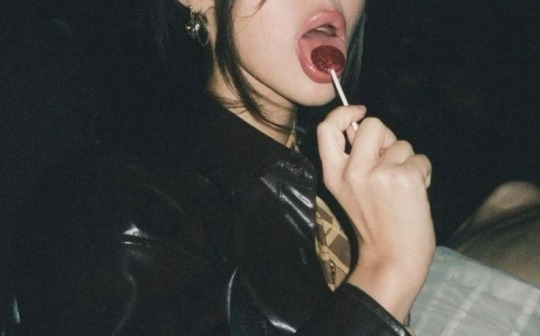

(these observations are general and do not cover all aspects)
♏︎ pluto shows where we burn, toughen, and become resilient. reaping the fruits of this process can be strenuous, and might be seen better in hindsight.
♏︎ the energies can be raw and primal, given pluto's urgency and intensity. centring obsession, compulsion, paranoia, etc.
♏︎ it can feel as though you symbolically enter a wound, refracting its pain back to you upon contact. the energies can be vile, and gory.
♏︎ pluto compels us to confront our deepest wounds, and demands us to see where our perception is tainted by trauma. it is an undercurrent, nudging us to the edge to fall (confront) - and rise (heal).
pluto in the first house
♏︎ a dominating placement since it falls in the house of 'identity', creating a deep resonance with plutonian themes. there's frequent retreat due to an early disillusionment about people's intentions - leading to relying on oneself. can detach from people and be cautious, extremely observant. you can find a detailed description on pluto conjunct the ascendant here.
♏︎ during transit: change in appearance, often 'darkening'. can be a time of vitality, endurance, and determination. coming out of introspection - redefining oneself.
pluto in the second house
♏︎ compulsively chasing security and resourcefulness, focused on materialism and control, fear of scarcity and being dominated – dealing with cyclical loss, creating a fear of losing ones foundation. this loss can range from opportunities, careers, assets or wealth to the loss of an identity or person (core wound).
♏︎ during transit: reclaiming what's been taken from you, having firm boundaries, accumulation and loss of wealth, defining value, learning that abundance starts from within.
pluto in the third house
♏︎ sensual voices - talking oneself into positions of power, feared for their intellect and silenced by those less competent. often critical of institutions. requiring depth and versatility - jack of all trades. loving banter and debate. intrigued by intelligence, quick and instinctual.
♏︎ can be extremely critical of themselves, downplaying their achievements even if they are exceptional. longing to be heard and valued.
♏︎ during transit: intellectual obsessions, craving taboo or occult knowledge, communal differences - questioning one's belonging, focus on mental health and what doesn't serve you.
pluto in the fourth house
♏︎ giving birth to creations through their pain - ancestral and domestic wounds that happened secluded and privately, inflicted trauma. highly intuitive and enduring, healing themselves and those to come. breathing life into everything they touch.
♏︎ where does life grow? in the mother's womb. what is inherent to this process? its cyclical nature. what does it consist of? sacrifice, dependence, excruciating pain, loss. what does it lead to? birth.
♏︎ during transit: domestic affairs or betrayal being exposed, secrets being told or asked to be kept. can be about loss, sacrifice, or distance to a beloved. creating boundaries or having them crossed.
pluto in the fifth house
♏︎ wounded inner child, being unable to create, often by force - a suppression of light. urge to be centred. tend to be erratic, having tunnel vision while creating. the initial 'wound' can vary in cause and effect based on how pluto's aspected. while pluto aspected by jupiter can create a feeling of superiority and a certain blindness to flaws, saturn causes doubt and repression, amplifying critique and diminishing one's work. same blindness, just flipped.
♏︎ during transit: immersing oneself in a project or person, craving to be inspired, finding a muse, dealing with copycats. being plagiarized or robbed of your creation. think of ai generated art based on artist's models or corporations stealing designs. (having upper hand despite fraud)
pluto in the sixth house
♏︎ destructive humility where one’s identity can dissolve – people feeling entitled to both their autonomy and service. demand to 'function' to a state of paralysis while disregarding their condition. worth can feel synonymous to performance.
♏︎ during transit: confronted with criticism, obsessive and compulsive tendencies in the mundane, change in routines, purification, having no 'saviour', learning to sacrifice for oneself rather than others. new ventures, e.g. professionally.
pluto in the seventh house
♏︎ fearing control and dependence - often seeking complex and unavailable partners in the house of 'others', with them being centred. there can be themes of possession, manipulation, and dominance, being sovereign. private and protective. being criticised in the public eye, confronted with jealousy and projection.
♏︎ during transit: business ventures and deals that need to be analysed carefully, focus on social class and status, entrance of opposing energies challenging your identity, keeping bonds private. having eyes on you.
pluto in the eighth house
♏︎ sexually reserved, treating sex and intimacy as something sacred or ritualistic. casual sex and intimacy drains them and generally can't be sustained. once committed they are bound. can have obsessive tendencies and high stamina. desired and charismatic, however out of reach.
♏︎ can be calculated and sense opportunities to gain power. psychological affinity allowing them to recognize patterns and behaviours. deeply tied to wealth (currency of power), either born into influential families or striving to attain status.
♏︎ during transit: having power and losing it, being stripped of everything you thought was yours. letting go of conditioned shame. financial dependence, trauma being centred (actively or in hindsight). intimacy, few but significant connections.
pluto in the ninth house
♏︎ the occult, philosophical expansion and psychic abilities - abundant yet compromised by structure. seeing past division and aching over discrimination, hatred, and coldness. receptive to transcendence, deeply wounded by closed hearts.
♏︎ when restricted or bound to a place the jupiterian expansiveness turns inward (mental). they are curious, wise, artistic, philosophical, and energetic. attempting to compromise their nature makes them burst (and leave).
♏︎ during transit: desire to attain higher education or specialising in a field, craving intellectual depth and mental stimulation, change of perception (also ideologies and religion), experimenting despite resistance.
pluto in the tenth house
♏︎ stunted legacy - often hindered by authorities or outer circumstances to achieve greatness, putting them at a disadvantage despite their capabilities. opportunities can be disproportionate to their potential. think of an excellent communicator working in a call centre. having to work harder than the average person.
♏︎ during transit: focus on public sphere and reputation, facing scrutiny and striving to be respected, peaking. can be about inheritance, passed on legacies, scandals, and authority. be strategic of what you put out, esp. online with pluto in aquarius. defending one's principles.
pluto in the eleventh house
♏︎ intelligent and analytical, craving originality and detecting lies without trying. can appear vain due to their selectiveness, needing mental stimulation, bored by repetitive and constructed thoughts. can be isolated - principle above sympathy. detached when nothing piques their interest.
♏︎ during transit: focus on higher concepts - disconnect that brings awareness to societal structures, innovation, and the subconscious. peak social awareness and calling out misbehaviour. pioneering esp. in tech and humanitarianism. decentralizing status, prioritizing impact.
pluto in the twelfth house
♏︎ being intertwined with the world's suffering and consumed by agony that isn't theirs. pain can be unrestricted since it transcends the material. the veil, to both humans and the otherworldly, is thin. feeling out of place, or surreal.
♏︎ mesmerizing eyes, and an existence between the worlds. characterised by sensitivity and wisdom beyond their years. esp. dominating when pluto in the 12h is conjunct their ascendant.
♏︎ during transit: loss of unity with their pain concentrated inward, can feel cataclysmic and fated. confrontation and healing of trauma. fear over losing our cognitive abilities and originality due to advancements, esp. ai.
#pluto#pluto through the houses#astrology observations#astro notes#astro tumblr#pluto in 1st house#pluto in 2nd house#pluto in 3rd house#pluto in 4th house#pluto in 5th house#pluto in 6th house#pluto in 7th house#pluto in 8th house#pluto in 9th house#pluto in 10th house#pluto in 11th house#pluto in 12th house
151 notes
·
View notes
Text
Other Characters you can legally use for your Mickey Mouse project

Mickey Mouse is in the public domain, as is Minnie Mouse and Peg-leg Pete. There's some caveats to that, and I talk about that more in this other post, but for now, let's talk about other characters who you can also use to fill out the cast.
These characters should all be in the public domain, though some characters still have treademarks. I'll get into how to use them safely as we go. Anyways, let's start.
Other Disney Characters

Disney obvciously doesn't advertise this, but there's actually quite a few Disney originals who've actually been in the public domain for a while.
The Mad Doctor never had it's copyright renewed, and so it's very technically the first Mickey Mouse cartoon to enter the public domain. Keep in mind, the version of Pluto featured in the short isn't in the domain just yet, but the Doctor himself is free to use.
What's funny is that Disney would later use a version of Doctor for Epic Mickey. Obviously don't use that version of the character.
Aside from the Mad Doctor, we also have Oswald and Ortensia

Yeah, as it turns out, Oswald's been in the public domain for quite a while, but he's still trademarked by Disney. Easy recommendation... use the original "fat" design of the character and have him go by Lucky.
But before Oswald, we have the Alice Comedies

Everything about the Alice Comedies is Public Domain for a long time, and the Disney corporation very rarely acknowlege these characters existence. Which is a shame because These shorts were some of the first shorts Walt ever produced, and they have the unique gimmick of featuring a live action girl in an animated world.
Everybody already knows about Oswald, but nobody talks about Oswald and Mickey's older brother from these shorts, Julius the Cat
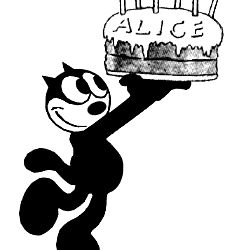
Like... yeah no, it didn't all start with a mouse. Or a rabbit. It started with a cat.
Foxy and Milton Mouse

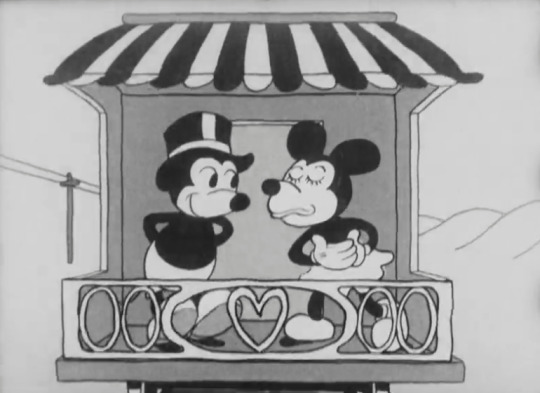
Both Foxy (top) and Milton (bottom, pictured with his girlfriend Rita Mouse) were characters created by Warner Brothers and Van Beuren respectively to cash in on Mickey's success, and both characters are also in the public domain.
In fact, all Van Beuren cartoons are apparently in the public domain, and I encourage you to find their cartoons and use them as you please.
Fleischer Characters

Betty Boop is probably in the Public Domain, but there's a few caveats with this. From what I can tell, the name Betty Boop is trademarked, but the character herself isn't. Most of the old Betty Cartoons are free to use, but newer incarnations, including the versions used in 1985's The Romance of Betty Boop and 1989's The Betty Boop Movie Mystery are still very much under copyright.
To avoid any legal trouble, I have two big recommendations. Although everybody remembers Betty as having Black hair, in one of the few early instances of Betty being shown in color, she's actually depicted as Redhead.
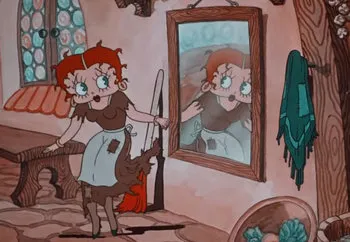
This is Betty Boop in 1934's Poor Cinderella, and her hair color is pretty clearly red.
The other option is to just make her black.
Though there's been some debate as to whether Betty Boop was intentionally modeled after Esther Lee Jones or not, there's still no denying the influence of Jazz on the character. Betty Boop is a Jazz singer and is often depicted dancing to Cab Calloway. Hell, the Betty Boop musical features Jasmine Amy Rogers as the titular character.
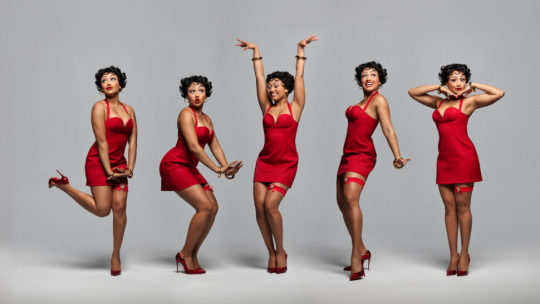
Betty Boop aside, there's an entire world of defunct Betty Boop characters who are definately public domain, including Bimbo and Koko the Clown.
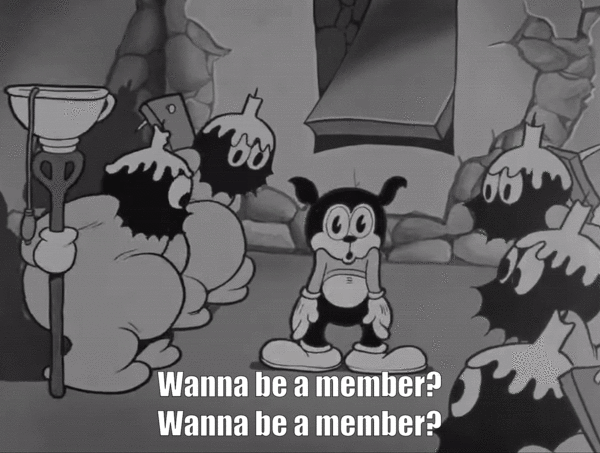
Next year, Popeye's also gonna enter the Domain. So keep an eye out for him too.
Anyways, these are my picks, but obviously this list isn't meant to be comprehensive. There's a ton of old cartoon characters out there who can be freely reinterpreted into newer works. Feel free to add your own favorite public domain cartoon to the list.
#Mickey Mouse#Public Domain#Betty Boop#Koko the Clown#Foxy#Milton Mouse#The Mad Doctor#Oswald the Lucky Rabbit#Alice Comedies#Disney#Walt Disney#Max Fleischer#Warner Brothers.#Cartoons#Animation#Editorial
1K notes
·
View notes
Text
The Two D&Ds
I am going to make two statements:
I despise D&D, and consider it a parasitic drain on ttrpgs as an artform.
I love D&D and my fascination with it continually inspires me to create art using it.
These two statements might seem to be at odds, but in fact there is no conflict when one considers that the term 'D&D' is being used to refer to two completely different things. I hate one of those things and like the other. So let's unpack that. Firstly, there's D&D-as-a-lifestyle-brand. D&D as presented by critical role, by memes about horny bards and wholesome gay tiefling found families, and by the wider hasbro-sanctioned fandom. Where the actual design and mechanics of the game are a vague suggestion that exists homeopathically in the same vicinity as what you're doing. But really, you're inventing blorbos, collecting pretty dice, and speculating on events in an actual-play on twitch; the rules in that very pretty rulebook are an afterthought to the fandom.
Then there's D&D-as-a-family-of-ttrpg-mechanics. This covers the various editions of Dungeons & Dragons - from the white-box OD&D to 5th edition and everything in between - as well as various retroclones, hacks and spin-offs such as the OSR, Pathfinder, etc. This isn't defined as a cultural space; it's a set of game mechanics and design principles shared across the text of various games. And there's a lot of variation with the specifics, but like The Blues, if you know the basic structure it all makes sense.
The two D&Ds have very little to do with each other.
When indie people like myself criticise D&D, we are usually criticising the first one. We're generally outsiders to that fandom-space who are unhappy with the way that fandom encroches on, and ultimately stiffles, everything else in ttrpgs as an artistic medium. We tend also to dislike the very shallow interest in that fandom of the things we care about in ttrpgs - game design, gameplay, theory, criticism, etc.
Here's the thing. I am, personally, immensely critical of D&D-as-lifestyle-brand. I detest it, honestly. It strikes me as a corporate exploitation of the wider medium in pursuit of an easy profit, at the expense of catering to the lowest common denominator. Like invasive kudzu, it chokes out all ecological diversity in the art-form. Its a homogenising influence, and in my experience pretty anti-intillectual.
Because, at risk of sounding like a pseud, I consider ttrpg design to be an art-form that merits serious effort, discussion and appreciation.
However. D&D-as-a-set-of-games I actually quite like. I find myself fascinated by the way so many games take apart the starting framework of a given edition of D&D - like your 12-bar-blues structure - and adapt it and riff on it and fuse it with other genres. I find it interesting to track the way whole movements and genres mutate out from that starting position. Hell, I do that myself, a lot. A lot of my design work takes the very early editions of D&D as a starting point, gets into a groove, and riffs on it until it's seemingly unrecognisable.
To me, a work like Mork Borg is D&D (the second definition). It is, however, totally unrelated and unrecognisable to D&D (the first definition).
So I will talk about "D&D as the containment game for shit players" and I mean it, because I'm talking about type-1. And I'll do that while designing a paleolithic OSR game, because that's type-2. And by and large, all that happens when both those things intersect is people get upset.
335 notes
·
View notes
Text
Why we don’t like it when children hit us back
To all the children who have ever been told to “respect” someone that hated them.
March 21, 2023
Even those of us that are disturbed by the thought of how widespread corporal punishment still is in all ranks of society are uncomfortable at the idea of a child defending themself using violence against their oppressors and abusers. A child who hits back proves that the adults “were right all along,” that their violence was justified. Even as they would cheer an adult victim for defending themself fiercely.
Even those “child rights advocates” imagine the right child victim as one who takes it without ever stopping to love “its” owners. Tear-stained and afraid, the child is too innocent to be hit in a guilt-free manner. No one likes to imagine the Brat as Victim—the child who does, according to adultist logic, deserve being hit, because they follow their desires, because they walk the world with their head high, because they talk back, because they are loud, because they are unapologetically here, and resistant to being cast in the role of guest of a world that is just not made for them.
If we are against corporal punishment, the brat is our gotcha, the proof that it is actually not that much of an injustice. The brat unsettles us, so much that the “bad seed” is a stock character in horror, a genre that is much permeated by the adult gaze (defined as “the way children are viewed, represented and portrayed by adults; and finally society’s conception of children and the way this is perpetuated within institutions, and inherent in all interactions with children”), where the adult fear for the subversion of the structures that keep children under control is very much represented.
It might be very well true that the Brat has something unnatural and sinister about them in this world, as they are at constant war with everything that has ever been created, since everything that has been created has been built with the purpose of subjugating them. This is why it feels unnatural to watch a child hitting back instead of cowering. We feel like it’s not right. We feel like history is staring back at us, and all the horror we felt at any rebel and wayward child who has ever lived, we are feeling right now for that reject of the construct of “childhood innocence.” The child who hits back is at such clash with our construction of childhood because we defined violence in all of its forms as the province of the adult, especially the adult in authority.
The adult has an explicit sanction by the state to do violence to the child, while the child has both a social and legal prohibition to even think of defending themself with their fists. Legislation such as “parent-child tort immunity” makes this clear. The adult’s designed place is as the one who hits, and has a right and even an encouragement to do so, the one who acts, as the person. The child’s designed place is as the one who gets hit, and has an obligation to accept that, as the one who suffers acts, as the object. When a child forcibly breaks out of their place, they are reversing the supposed “natural order” in a radical way.
This is why, for the youth liberationist, there should be nothing more beautiful to witness that the child who snaps. We have an unique horror for parricide, and a terrible indifference at the 450 children murdered every year by their parents in just the USA, without even mentioning all the indirect suicides caused by parental abuse. As a Psychology Today article about so-called “parricide” puts it:
Unlike adults who kill their parents, teenagers become parricide offenders when conditions in the home are intolerable but their alternatives are limited. Unlike adults, kids cannot simply leave. The law has made it a crime for young people to run away. Juveniles who commit parricide usually do consider running away, but many do not know any place where they can seek refuge. Those who do run are generally picked up and returned home, or go back on their own: Surviving on the streets is hardly a realistic alternative for youths with meager financial resources, limited education, and few skills.
By far, the severely abused child is the most frequently encountered type of offender. According to Paul Mones, a Los Angeles attorney who specializes in defending adolescent parricide offenders, more than 90 percent have been abused by their parents. In-depth portraits of such youths have frequently shown that they killed because they could no longer tolerate conditions at home. These children were psychologically abused by one or both parents and often suffered physical, sexual, and verbal abuse as well—and witnessed it given to others in the household. They did not typically have histories of severe mental illness or of serious and extensive delinquent behavior. They were not criminally sophisticated. For them, the killings represented an act of desperation—the only way out of a family situation they could no longer endure.
- Heide, Why Kids Kill Parents, 1992.
Despite these being the most frequent conditions of “parricide,” it still brings unique disgust to think about it for most people. The sympathy extended to murdering parents is never extended even to the most desperate child, who chose to kill to not be killed. They chose to stop enduring silently, and that was their greatest crime; that is the crime of the child who hits back. Hell, children aren’t even supposed to talk back. They are not supposed to be anything but grateful for the miserable pieces of space that adults carve out in a world hostile to children for them to live following adult rules. It isn’t rare for children to notice the adult monopoly on violence and force when they interact with figures like teachers, and the way they use words like “respect.” In fact, this social dynamic has been noticed quite often:
Sometimes people use “respect” to mean “treating someone like a person” and sometimes they use “respect” to mean “treating someone like an authority” and sometimes people who are used to being treated like an authority say “if you won’t respect me I won’t respect you” and they mean “if you won’t treat me like an authority I won’t treat you like a person” and they think they’re being fair but they aren’t, and it’s not okay.
(https://soycrates.tumblr.com/post/115633137923/stimmyabby-sometimes-people-use-respect-to-mean)
But it has received almost no condemnation in the public eye. No voices have raised to contrast the adult monopoly on violence towards child bodies and child minds. No voices have raised to praise the child who hits back. Because they do deserve praise. Because the child who sets their foot down and says this belongs to me, even when it’s something like their own body that they are claiming, is committing one of the most serious crimes against adult society, who wants them dispossessed.
Sources:
“The Adult Gaze: a tool of control and oppression,” https://livingwithoutschool.com/2021/07/29/the-adult-gaze-a-tool-of-control-and-oppression
“Filicide,” https://en.wikipedia.org/wiki/Filicide
#repost of someone else’s content#medium repost#Alba M.#purity culture#ageism#adultism#youth oppression#childism#child abuse#parental abuse#youth rights#youthlib#youth liberation#parricide#nuclear family abolition#anarchism#note: I would consider reevaluating the demonization of adults who kill their parents too#many victims remain entrapped well into adulthood#there are still a lot of issues of economic dependency and control especially for young adults#and I don’t think such a totalizing power imbalance engendered in childhood is so easily levelled#even if an adult does become financially independent#likewise for adult victims of intimate partner abuse: also structurally made difficult for them to leave#even if not criminalized to the same degree#anti-abuser aktion
3K notes
·
View notes
Note
Regarding the semantic limitations of capeshit, is there a decent term for "superpowers exist but capes and costumes just isn't a thing for whatever reason" be it due to it never occurring in the first place or due to the status quo settling without capes and costumes and the whole hero vs villain duking it out thing? Like especially the it never occurring in the first place I find quite interesting, and is something I see often enough in media in which magic and spells are innate and the consequences of that power being unrestricted and unpredictable, but I don't think that is termed either afaik
I think that the TVtropes parlance for this is "Not Wearing Tights-" works with that label are often in conversation with or direct adaptations of traditional cape-and-costume superhero stories but with the aesthetic sanded down out of a combination of budget pragmatism and excessive self-awareness.
Unfortunately it's kind of a self-justifying trope in a lot of ways because the logistics of creating an effective traditional costume are genuinely batshit crazy on a lot of levels. Wild Cards is a setting where the idiom exists but fell off as a mass practice because there were very few would-be heroes with powersets and resources that made a typical superheroic presentation practical. Mutant City Blues is a TTRPG setting where, in the face of widespread mutation, would-be "traditional" heroes exist but are largely limited to the convention circuit for liability and practicality reasons and are viewed as unserious weirdos by those who tend to their business in plainclothes. Heroes is a universe where there are several characters who probably would costume up if the opportunity presented itself but shit's going down too fast and too constantly for that to ever become workable. Ex-Heroes is a setting where many of the powered vigilante heroes used to have costumes but they were almost universally really shitty hack-jobs produced on shoestring budgets, propped up aesthetically by the users put-up-or-shut-up ability to flip cars and fly, and, in the face of zombie apocalypse that defines the setting, eventually became just too much of a pain in the ass to repair and replace.
Mass adoption of costumes and code names is, unfortunately, something a setting actually has to do a lot of legwork to justify, and this has been true since at least Silver-age marvel, where, if you go back with a fine toothed comb, a surprising number of the characters are visibly coming to their heroism from a showbusiness perspective- Spider-Man the would-be wrestler, Daredevil the son of a prize fighter, Hawkeye the circus performer, Iron Man the unofficial corporate mascot, Wasp the fashion designer, Cap the USO propaganda object, this crops up a lot. Likewise, works like Worm and Abberant and The Boys burn a lot of narrative capital on the logistics of acquiring a costume that doesn't suck shit, and the proximity to power that a really high quality costume implies.
69 notes
·
View notes
Text
Writing Notes: Heraldry

Heraldry - is about showing people who you are.
In England, it started in the later 1100s, when knights began to wear helmets, and they couldn't be recognised. So they began to paint unique combinations of colours, shapes and animals, called their 'arms', on their shields and banners. Only one person was allowed to use these arms. When people saw a knight wearing them in a battle or tournament, they could tell who he was.
It is the science and the art that deal with the use, display, and regulation of hereditary symbols employed to distinguish individuals, armies, institutions, and corporations. Those symbols, which originated as identification devices on flags and shields, are called armorial bearings.
Strictly defined, heraldry denotes that which pertains to the office and duty of a herald; that part of his work dealing with armorial bearings is properly termed armory. But in general usage heraldry has come to mean the same as armory.
The Colours of Heraldry

The 5 traditional colours are, with their heraldic names:
Red = Gules
Blue = Azure
Green = Vert
Black = Sable
Purple = Purpure

Plus the two 'metals':

Gold or yellow = Or
Silver or white = Argent
There are also 'furs', the most common being:

Ermine: representing the white winter fur of stoats, with their black tail tips.
Vair: representing squirrel skins, in blue and white.

If something (say a dog or badger) is shown in its natural colours, it's called proper.
Conventional representations of tinctures used when it is not possible to print the actual colors:

Heraldic Ordinaries

Ordinaries - the simple shapes used on heraldic shields, against a colour, metal or fur background. If you are making your own design, choose one of these main ordinaries:

Fess = horizontal stripe across the shield
Pale = vertical stripe down the shield
Bend = diagonal stripe
Chevron = like a house gable, pointing upwards
Cross = a plain cross
Saltire = a 'St. Andrew's cross'
Chief = bar across top edge of shield
Bordure = border round edges of shield
Pile = downward-pointing triangle

You can also divide your shield into two colours, either vertically or horizontally, or into four different-coloured quarters.
You don't have to use an ordinary, but if you do remember to never put a colour on colour or a metal on a metal. Try to remember this heraldic rule: colours don't show up well against colours, or metals against metals. This also applies to charges.

Heraldic Charges
Charges - emblems added to the shield, on the background, the 'ordinary', or both.
There can be one big charge, or several smaller repeated ones. Here are some of the common charges you could use:
Crosses - of many different types
Stars
Rings
Balls
Crescents
Diamonds
Flowers
They can be any colour, but remember never put colour on colour, for example a green star on blue, or metal on metal, for example a white flower on yellow.
Many knights also used animals as charges.
Animal Charges

Any animal - either one big one or several smaller - can be used as a charge. They can be shown in many different ways, for instance:
Rearing up (rampant) - like the lion and the hare in the pictures above
Standing (statant) - like the dog
For birds, with wings outstretched (displayed) - like the eagle
Walking along (passant) - like the other lion
If the animal is looking towards you, it is also guardant or 'on guard'. So the lion in the picture is passant guardant.
The ancient royal arms of England are 3 golden lions, one above the other, walking along on a red shield: or, in heraldic code, gules three lions passant guardant or.
Just to make things more complicated, lions passant guardant are also called leopards - but they don't have spots.
Choosing Your Animal
Animals symbolised different qualities. So for instance:
Lions = bravery
Dogs = faithfulness, reliability
Stags = wisdom and long life
Eagles = power and nobility
Badgers = endurance or 'hanging on'
You could also design your own animal charge.
For instance a cat, horse or other favourite pet.
Or you could choose a fabulous beast...
Fabulous Beasts

Though often used as 'charges', these fabulous beasts never really existed.
But some people believed they did, maybe because they'd heard about them in stories made up by travellers to distant lands, like crusading knights or merchant adventurers. Pictures of them also appeared in 'bestiaries', a popular kind of illustrated medieval story-book.
Here are some you could use:
Dragon: the earliest and most common fabulous beast, also used as a badge by Romans, Anglo-Saxons and Welsh. A brave and cunning defender of treasure.
Griffin: a combination of lion and eagle. Symbolises watchfulness and courage - and also guards treasure.
Cockatrice: a cross between a cockerel and a dragon, supposedly hatched from a cock's egg by a snake or toad. Could kill by looking at you, and symbolised protection.
Manticore or 'man-tiger': a fearsome man-eating creature with a lion's body, man's face, tusks, horns and a deafening trumpet-like voice.
Cadency

Cadency - the use of various devices designed to show a man’s position in a family, with the aforementioned basic aim of reserving the entire arms to the head of the family and to differentiate the arms of the rest, who are the cadets, or younger members.
Heraldic works in the 16th century refer to cadency marks as:
a label for the eldest son during his father’s lifetime;
a crescent for the second son;
a mullet (five-pointed star) for the third;
a martlet (a mythical bird), the fourth;
an annulet (a small ring), the fifth;
a fleur-de-lis, the sixth;
a rose, the seventh; and so forth.

Sources: 1 2 3 4 ⚜ More: Writing Notes & References
#heraldry#writing notes#writeblr#dark academia#spilled ink#literature#writers on tumblr#writing reference#writing prompt#poets on tumblr#poetry#symbols#light academia#writing inspiration#writing ideas#creative writing#lit#fiction#writing resources
84 notes
·
View notes
Text
Nobody needs another TTRPG taxonomy but I made one anyway
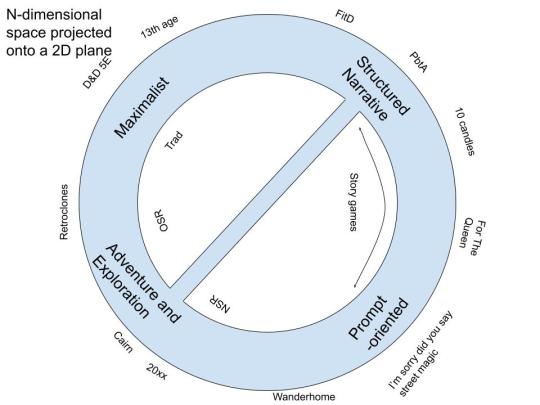
Posted here: https://seedlinggames.com/blogging/discourse/game_taxonomy_part_1_v_1.html I have a second blog post that is going to explain the small diagonal line, but basically it's that I think there is influence between those two camps that people don't seem to talk about much, probably due to internet discourse reasons
A million people have already done this - I'm kind of assuming you have vaguely absorbed the existing Internet discussions, and are familiar with terms like OSR, Story Games, etc. If you haven't, run away now and save yourself. But Six Cultures Of Play is probably a prerequisite to understand what I'm talking about, or at least what I'm complaining about.
I will try to, as much as possible, only discuss games that I have played. A lot of taxonomies seem to be written by someone who clearly likes one type of game a lot more than the others. For instance, I will not be discussing LARP because I don't have any relevant experience. I'm also not claiming that I am discussing the complete set of all games that exist, but I think I have played enough of them propose a taxonomy. If you're curious, I have an approximately complete list of games I've played or run here.
What is a TTRPG?
First we're going to have to look at everyone's other least favourite subject of conversation.
TTRPGs have 2 or more people taking on the following 3 roles:
A player, who is responsible for one or more characters who are the protagonists of the story.
A GM, who is responsible for the remainder of the story, such as providing additional characters and other aspects of the environment that the main players exist in. To do so they might determine the outcome of uncertain events or interpret rules agreed upon by the table.
An author, who provides additional, reusable material without being present. I'm using the term "author" for a lack of a better one, but it includes game books, blog posts, maps, drawings, or even fixed principles transmitted orally from game group to game group. These serve to facilitate or even replace GMing, as well as to introduce new ideas to the table without someone being physically present.
The same person often takes on different roles at different times, sometimes in the same game.
If you have only one of these roles, you are probably writing a book, doing improv, or some other activity. Which is of course totally fine.
This isn't the only definition you could come up with, but I think most people would agree it isn't totally wrong, and it's a lens that I'll be using to discuss the game taxonomy.
Maximalist Games
Apparently "maximalist" means something specific in art but I am not educated in such things and might be using the word wrong.
Characteristics of a maximalist game:
The three roles: clearly present and distinct, with the GM and author each taking on a large responsibility for the game experience.
Modularity: Semi-modular: There is a main game system which is designed to be extended by other modules, but these modules cannot be used with other games easily. A game book is typically not a self-contained experience and games are usually open-ended in duration.
Rules: A lengthy, complex ruleset with subsystems for resolving different parts of the game that are likely to come up, primarily oriented around the success or failure of an action and its consequences.
Characters: The complex game mechanics provide an opportunity for players to develop a distinct character before playing them, defined by game mechanics. Character and player motivations are usually aligned.
Narrative structure: Campaigns usually follow conventional narrative structure, but this is driven primarily by the GM, or by adventure modules, which define an outline of the narrative.
Who makes them: Often require more resources to create and thus are made by corporations, but that is changing.
Relationship to other media: While often inspired by fantasy novels, their larger budget and longer history has allowed some of them to develop their own genre conventions distinct from other media, and in some cases have inspired movies and books.
Solo games: Rare, due to the prominent role of the GM.
"Trad" games are a subset of these but a) I hate that word and b) I think the genre, starting especially with 4E and other inspired games, have gone in some very different directions. It roughly corresponds to "Fight D&D" in the Between Two Cairns taxonomy, but some games in this category involve no fighting at all.
Narrative Mechanics Games
The three roles: Blur the lines between GM and player more freely.
Modularity: Usually not very. Each game is made to create a specific experience, and the blurring of GM and player roles makes adding external content more complicated.
Rules: Focused on resolving problems in the context of narrative structures. Rules may facilitate pacing, allow for storytelling outside of linear time, allow players to temporarily take on a GM-like role, and allow for players to work together to create conflict between their characters.
Characters: Mechanics facilitate creating characters according to genre conventions with defined relationships to other characters and to NPCs. Player and character motivations are often not aligned.
Narrative structure: Rules are designed to support conventional narrative structures and genre conventions.
Who makes them: The focused scope of these games mean that they are often made by individuals rather than corporations, but there is a trend towards some of them being made by mid-sized organizations. Long development cycles may be needed to provide a polished experience, leading to some amount of professionalization.
Relationship to other media: Usually strongly inspired by other media, allowing you to create stories similar to movies, books, TV shows, etc.
Solo games: Rare, with Ironsworn as a notable exception.
Some "story games" fall into this, but I think "story games" has split into two meaningfully distinct categories. I've met enough people who only like one of the two categories. I think they are perceived as more similar than they are because there's less internet drama about the difference between them.
Prompt-based storytelling
The three roles: Blur the lines between the GM, player and author, with the GM often being absent.
Modularity: Usually self-contained experiences with limited modularity.
Rules: Often entirely forego mechanics for failure or success; mechanics tend to be minimal and about making suggestions regarding the story to tell, with the written text sometimes acting primarily as a GM or even player who is not present.
Characters: Character creation is usually a minor to nonexistent part of the game, with characters being defined by decisions made at the table. In some cases, all characters are already predefined. Characters are usually defined in words rather than numbers. Player and character motivations are rarely aligned.
Narrative structure: Stories often forego conventional narrative structures, and are focused around exploring relationships, ideas, or experiences. If a narrative structure is defined, it is usually in the form of a defined endpoint, with the purpose of the game being to explore how the characters get there.
Who makes them: Leans heavily towards DIY or single creators. Often comes in formats other than books.
Relationship to other media: Inspiration comes less from established genres and more from life experiences. Genre fiction is less likely to be an inspiration.
Solo games: Very common, due to the reduced role of the GM.
Adventure/exploration games
The three roles: Blur the lines between GM and author, both at the table and culturally.
Modularity: Are highly modular: not only are supplements and adventures often interchangeable, but are often not tied to specific systems.
Rules: Have relatively short rulesets focused on generating situations (on the GM side) and resolving danger (on the player side).
Characters: Characters are mostly created organically in play through interactions with the environment, including the tools at their disposal. Random generation is common. Character and player motivations are usually aligned.
Narrative structure: Campaigns often do not follow a typical narrative structure, aside from perhaps an escalation in danger, scope and/or strangeness.
Who makes them: Their modular nature means that they are often created in a DIY manner, through zines, blog posts, and informal discussions, though mid-size companies are also prevalent.
Relationship to other media: Inspiration from other media is often mostly vibes-based, with genre fiction, folklore, and even musical genres and political movements (for better or worse) being prominent. It doesn't seek to emulate the characters or narrative structure of other genres.
Solo games: Relatively common, usually provided by an additional module that may be specific and general-purpose, often focused on a GM emulator known as an "oracle."
"OSR" games are a subset of these, but a good number of these also make many OSR people very angry. It roughly corresponds to "Door D&D", but dungeon crawling is not inherent to this genre.
Other ways of looking at these categories
You could also map these on axes:
distinct GM/player/writer role vs combined roles: maximalist vs prompt-based at opposite ends of this spectrum
Highly self-contained vs highly modular: narrative vs adventure/exploration
Strong genre conventions vs naturalistic approach: maximalist/narrative vs adventure/exploration/prompt based
Resembles a D&D vs does not really resemble a D&D: maximalist/adventure/exploration vs narrative/prompt based
for symmetry I want to put another axis for maximalist/prompt based but I can't think of anything they have in common. Oh well.
But I also don't think this is a complete enumeration of all possible types of games either - this is some kind of n-dimensional space that has only 4 blobs on it
The part of the taxonomy blog post where you realize this is actually just me going on about my own preferences this entire time
I've played and enjoyed all 4 types of games, but putting this together has helped me figure something out - why it is that I like both the NSR side of OSR games and like the "super weird" story games. And why I don't seem to be the only one, even though these are often talked about as opposites. Because if you split story games into two genres, the similarities between prompt-based games and adventure/exploration games comes out.
54 notes
·
View notes
Text
"The idea of it..."

This is obviously a reference to the ol' argument:
"The Jedi weren't bad but the Jedi Order as an institution needed to go."
So as a quick reminder I thought I'd point out:
1) George Lucas describes the Jedi's eradication as a sad thing, not something sad-but-necessary:
"[The] Jedi getting killed through the Order 66 of the clones is just done as one of those kind of inevitable pay offs in terms of getting rid of everybody, the Emperor is getting rid of all his enemies, but there’s a certain inevitability of it all and a sadness to it. - Revenge of the Sith, Director’s Commentary, 2005
2) Out of 770 George Lucas quotes, I've never seen him refer to the Jedi Order as "an institution" once.
He does refer to the Republic itself as an institution.
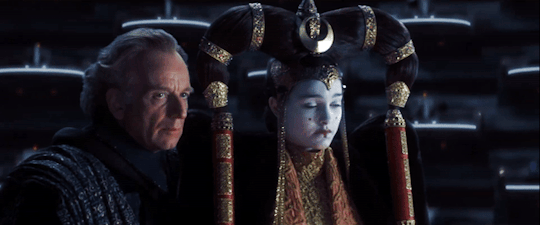

"[In The Phantom Menace one of the many storylines is] the story of a young queen who's faced with the total annihilation of a people, and how she can get a sluggish political institution to pay attention to what's going on." - Premiere, 1999
He might be referring to the Senate instead of the Republic as a whole, but the point stands: he's not talking about the Jedi.
Which tracks with what Lucas defined as Dooku's reason for leaving the Order: his disenchantment with the Republic/Senate, not the Jedi themselves.
But let's go slightly further:


The Jedi Temple was designed as a place of worship that would contrast with the corporate coldness of the Senate.

Also, the Jedi were originally designed as a more organized police force. As the script evolved, they were turned into peacekeepers, diplomats.


Mace's room was redesigned so as to not convey that the Jedi were mired in bureaucracy and protocol.
And when describing the political situation of the Prequels, Lucas doesn't blame the Jedi, but rather the corporations and Senate:
"But as often happens when wealth and power grow beyond all reasonable proportion, an evil fueled by greed arose. The massive organs of commerce mushroomed in power, the Senate became corrupt, and an ambitious named Palpatine was voted Supreme Chancellor." - Shatterpoint, Prologue, 2004
Wow, it's looking like not only is the "Jedi Order as an institution needed to go" narrative not a thing per Lucas, but
3) Lucas went out of his way to make it clear that the Jedi aren't the issue, here, the Republic/Senate is.
So how did we get this narrative?
Well, it comes from a generation of fans and Star Wars creators who were not the target audience.
You know the type. It's the kind who, when asked if they like the Prequel Trilogy, will respond that they liked...

... but not the execution.
AKA they disliked the Prequels, but then EU books and The Clone Wars came out and provided them with enough material to form a headcanon justifying why they didn't like the Jedi, despite wanting to: it's because the Jedi are meant to be disliked! Totally!
The Jedi failed as an institution is an idea that comes from authors who wanted to engage with the material (it IS Star Wars, after all) but not the narrative that George Lucas had crafted, whose work then influenced older fans who preferred the author's retconned version of the story to the original one.
The rest is history.
As Prequels producer Rick McCallum put it:
"The myth begins on paper. During preproduction, filming, and postproduction, the myth becomes visible through the work of hundreds of dedicated people. Following the film's release, the myth becomes public and the public makes it its own." - Rick McCallum, Mythmaking: Behind the Scenes of Attack of the Clones, 2002
#I find it ironic that Filoni unwittingly gave Baylan the same line repeated by 'Prequel fans' who only became fans by...#... injecting gray morality into the films and said “it was there all along! the Prequels are subversive films!”#They're not. They're films for kids. The SITUATION is more complex than in the Original Trilogy... but the morality is still good vs evil.#baylan skoll#ahsoka series#jedi order#george lucas#meta#star wars#ahsoka spoilers#ahsoka show#ahsoka#in defense of the jedi
523 notes
·
View notes
Text

East District Apartment is a minimalist apartment located in Zhengzhou, China, designed by Seemore Design. A quiet revolution in design unfolds through an unexpected gesture: the deliberate setback of an entrance. This architectural pause, described as a “house within a house,” represents more than mere spatial planning—it’s a manifesto against the homogenized corporate environments that have come to define China’s rapidly expanding business districts.
40 notes
·
View notes
Text
𝐒𝐈𝐆𝐍 𝐓𝐇𝐄 𝐂𝐇𝐄𝐂𝐊, 𝐁𝐀𝐁𝐘 — m. reo

𓆩ᥫ᭡𓆪 saving the world, one coerced check at a time
tw. husband!reo, reader was an air stewardess, t!t job, deep throat, edging, riding, 1 slap (not towards reader), talks of climate change, both reader and reo are switches, coercion
tagging @katasstrophy riv it’s been way too long since we last talked about this but here’s the husband!reo piece i was being a menace with (like finally)

Reo Mikage was a lot of things.
A husband. A philanthropist. A soccer player with a huge legacy.
But, he also had a huge ego deep enough to rival the Marianas Trench. Good quality food, high class hotels and exceptional services at restaurants were something he would never compromise on. Another thing which he would never bend for? Shoddy charities.
“Always a new one popping up every damn time,” he grumbled next to you, scrolling through his phone. “You gotta wonder if the government is controlling them.”
You, on the other hand, were his exceptionally giving wife. Your days as an air stewardess filled you with grit and knowledge of different views—opened you up to worlds of possibilities where the idea of a better world was right within reach. You grew up with a sense of responsibility for the environment. What humans gave to mother nature, it would be returned back tenfold.
Reusing, recycling and reducing were important in your life. Sadly, Reo was not of the same opinion as you were.
He was brought up in a life of excess. Surplus flowed in his blood with the idea of more guiding his life. He strived to do more, see more, gain more. Always and every time without fail.
“They’re trying to help save the planet, love,” you hummed, curling yourself onto his chest. Reo tutted and pushed his horn-rimmed glasses up the slope of his defined nose, curling one defined arm around your waist.
“Fat load of help that would be. You should put your money where your mouth is if you want to achieve such a feat. Tch.”
Your stomach sank slightly at his words. You never expected him to spew such a fascinating statement. The text you had received from a long-time friend burned in your messages, and you had mulled over how to respond to it. How to respond to her desperate plea to help support her waning environmental lobbying agency.
Kira Ryosume was one of your oldest colleagues. She was a dear friend who offered you a lot of advice when you were just a novice air stewardess. She was a decent person who deserved to have her dreams come to life.
A dream of finally passing an environmental bill which would mandate large corporations to register for the Carbon-Neutral Treaty. As expected, none of these businesses wanted to take part in such an altruistic event unless their bottom line would be greatly boosted.
¥20 million. She needed that amount to even think about publishing the treaty.
You flattened your lips and eyed your husband. Mikage Reo’s defined abs and biceps pulsed in the half-light from the designer lampshades by your side table. After two years of marriage, Reo was still delectable to you—one of the finest men you ever had the pleasure of sleeping with. After all, he had made the impossible possible by getting you to commit to him for your entire life.
Slowly, your hands roamed down his torso, touching the notched scars of his body from those years he played pro on the soccer fields of the world. Grazing his rosy pink nipples, you heard his hitched breath exhaled in your hair, spurring you on. Counting the moles on his abdomen, you gently traced the burst of his lilac happy trail, leading straight to the sharp ‘V’ carved delicately above the band of his sweatpants.
“Sweetheart,” he grunted, unable to stop your caresses because why would he?
Reo lived for any attention you gave him.
The one thing you were intimately acquainted with about your beloved husband was that he hated anything which was not a challenge. Truly—a consequence from his upbringing which saw him getting everything he wanted anytime. Your lips curved upwards into a sinful smile. He was always so fun to ruin.
Achingly slow now, you tugged the expensive Calvin Klein band down, dipping your fingers beyond it to graze his stirring length. Reo’s hips started to tick when you massaged the flushed pink tip between your thumb and forefinger, though he tried to play it cool.
Unexpectedly, you tightened your fist around his length, drawing it up slowly, and your grin grew wider when you felt a spurt of wetness running down your wrist.
Reo hissed and set his phone down onto the side table, removing his glasses. His abdomen tightened, and you felt his heart thump unevenly under your cheek. You perched your chin on his left pec, gazing deeply into his glassy lilac eyes. Judging from his flushed cheeks and slightly parted lips, he was already drunk on your touch, his will crumbling to leave him susceptible to your misdoing.
And you loved the rush of power it elicited in you.
“What’s gotten into you?”
His voice was a low, scratchy whimper. You pressed yourself closer to him, lips in the hollow of his neck, the teasing puffs of your hot breath raising goosebumps on his skin.
“Can’t I pleasure my own husband?” you breathed, batting your lashes at him. Completely having him at your mercy.
Reo grunted, his mid-length purple locks brushing your shoulder when he used one large hand to part your thighs, cupping your mound. In retaliation, you snapped your legs closed, trapping his hand there and giving him a grin in response to his confusion.
“Wanna focus on you, baby.”
He moaned in surprise when he felt your wrist twisting around his leaking cock head. “I—hah—w-wait…” You started to jerk him off faster now, and Reo’s chest took on such a pretty flush you couldn’t resist tonguing his pebbled nipple.
Your husband was not an idiot. He had years of experience to sense that you were trying to get something out of him by riling him up. Though, Reo was drawing a blank as to what exactly you needed.
“You w-want something,” he tried to sound accusatory, but it came out as a breathless mewl instead. “S’that true? T-tell me.”
You unlatched your lips from his throbbing nipple, doe eyes wide on him as you slowed down your pace. Reo’s hips stuttered, that glassy look in his eye growing lucid at your little laugh.
“You got me.” Sitting up, you kept your palm loosely around his cock, shifting your hair out of the way to slip your nightgown straps down, revealing your perky nipples to the cool room. Reo groaned at the sight of you shifting in between his legs, that vixen-like smirk still on your face and his cock now in between your breasts.
The sight of a globe of spit falling from your mouth and onto his throbbing tip made him curse under his breath. Reo stopped you before you could put him in your mouth with a hand on your cheek, his expression flustered and brows knitted.
“Well? What is it? A new bag? More clothes? Tell me what you want, my love, and I’ll try to make it happen.”
It was remarkably easy to leave your husband in a bind with such simple actions, especially when you pretended to think his preposition through, letting him stew in his frustrated silence, the hand around his cock still leisurely pumping him up and down up and down base to tip base to tip until he shuddered lightly.
“L-Love?”
“¥20 million,” you murmured, and before he could react at the amount, you dragged your tongue slowly and seductively across his soaked head, lapping at the beads of precum staining down his length. Leaving him reeling from both the pleasure and the shock of such a demand.
Reo jerked back like he had been electrocuted, hissing loudly. “Fuck! F-fuck… what do you need with that much money?” He fisted your hair in one hand, completely entranced by your plush lips wrapped around his cock.
You let him go with a soft pop, humming. “You said it earlier. Those damn environmental agencies. I want to donate some money to them to help them solve the pollution companies like yours cause.”
Reo’s eyes widened, and he sputtered indignantly; his fury lost in a moan when you started to deepthroat him.
“Shit,” he cussed, low and hoarse, watching you with heavy, lidded eyes when you need to bob your head up and down his cock. “S’all it is to it? You wanted to play a hero? Baby, you started to try harder than that.”
You hummed around his length, fully expecting his resistance. Drooling around his pulsing length, your eyes met his, framed by your determination, he could only fist the sheets as you took him down to the hilt. Reo groaned, loud and husky, when your nose touched his lilac pubic hair.
“S-shit, baby… you know that’s not fair…”
Reo’s whine was adorable, and so was his cluelessness to the next ace you had up your sleeve. Keeping your teary eyes locked on his, you started to shallowly use your mouth as a makeshift sleeve to tighten and suck his cock for what it was worth.
He could barely hold back a loud yelp when you played with his balls along with your maddening movements.
You sensed he was close from his heavy breathing. Reo was fisting your hair for dear life, his thighs trembling underneath your body.
Before his pleasure could culminate in one swooping orgasm, you pulled back, letting a weak stream of his cum hit your chin. Ruining his release with an angelic smile.
Reo sagged back against the pillows, huffing like he had just finished a game. “Fuck… you’re mean…”
In answer to his astute observation, you licked your lips and gathered his cum slowly dripping down your jaw to suck it off your finger. His taste was clean and musky, and you made sure to show him how much you appreciated it.
“Mmm… you taste so good, baby.”
Reo whimpered at the sight of you fully removing your nightgown, leaving you in the nude.
You took the chance to straddle his lap, manicured nails wrapping around his cock again and tugging playfully.
“Changed your mind yet, rich boy?” You had not used that taunt on him for years now since the both of you had gotten married. Reo’s nostrils flared, his blood rushing south once more to thicken his girth in your teasing hold. The number of times he had punished you for calling him that stupid term… and you were riling him back up, spreading your legs and circling his leaking tip around your soaked entrance.
You were asking for it now.
Reo enjoyed knocking you down a peg or two when he flipped you onto your back, your wide eyes and tiny squeak sending his ego to the orbit.
“Yeah,” he mumbled, fisting his length and slowly easing into you, splitting you wide open with his thickness and determination. Your nails stabbed into his shoulders, and your cry of ecstasy was smothered by his palm over your mouth. “You drive quite the hard bargain there, missy and I’m interested.”
Your muffled wails soothed him; made a woozy smile appear on his face. Such a pretty little crybaby, Reo thought. Too bad you tried to take control of him. It was a shame. He was prepared to give you enough orgasms tonight to leave you bed bound tomorrow. He watched, entranced, as your eyes rolled back into your head, only the glimmering whites exposed.
All the teasing you did culminated in a slippery mess between your legs. It looks like Reo wasn’t the only one affected by your teasing.
His smirk deepened when he moved one hand in between your sweaty, writhing bodies, thumbing your clit in greasy circles; holding you down as you tried to push him off from the overstimulation.
Reo chuckled, low and deep, when your mewls reached his ears.
“Always have to put you back in your place, huh?” He breathed, cocking one perfect lilac brow up. “When will you learn? You’re mine. I own you. You can’t just pull this shit on me.”
Somehow, his fingers ended up in your mouth, choking you while pinning your tongue down to the base of your throat.
Reo clicked his tongue, arrogance dripping from his faux grin of sympathy when you buckled and twisted in his hold. “Too much?”
Your garbled rendition of his name had the monster in him feening for more of your submission. He clasped one hand around your neck, holding you down as he parted your lips with one sturdy thumb.
“Open wide. Wider.”
You obediently unhinged your jaw, slowly unfurling your tongue out for his scrutiny. Reo wasted no time in gathering a globule of spit, letting it dangle teasingly from his lips before the taste of him smothered your tongue.
“Swallow.”
You do, your walls rippling around him in response to his dominance.
“Fuck. S’a good girl.” His unexpected praise makes both your pussy and heart clench; leaving you yearning for more.
Reo could play nice and let you take the lead on some days, but tonight, you had pushed his buttons hard enough.
His cock drilling into you was enough of an indication of his frustration, and the ex-pro player didn’t care for your high strung whines when he pulled out of your swollen depths, about to leave you unsatisfied and covered with his cum when you rolled him onto his back, swiftly gripping his wrist to impede his movement.
Reo yelped, and before he could chastise you, your palm landed lightly across his cheek. The simmering orgasm you had started an hour ago fizzled in his veins, and he growled, jaw and cock smarting. “Why you—”
His words were cut off by your lithe fingers slipping him back into your heat. Reo was powerless to stop you from sensually grinding down his cock, your half-hooded eyes and quivering tits enough of a consolation for his wounded ego when you took back the power and control. Those large, veiny palms of his cupped the flesh of your ass, kneading surely, appreciatively. Enjoying the sight of his wife riding him to oblivion as his cock twitched and tightened once more.
The coil in his belly started to tighten, and before he could completely blow his load, you stopped all movement.
It took every ounce of self-control he had to not jackhammer up into you like a mad dog, a snarl twisting his handsome features.
“Y/N—”
“Sign the check,” you murmured, leaning back slightly to give him a full view of his cock splitting apart your messy folds. It was strategic—this little seduction game of yours. You knew he couldn’t resist watching you play with yourself, his voyeuristic nature emerging to greedily drink in the sight of your curves contrasting with the hard planes of his abs. Reo gulped audibly when you traced one hand down your torso slowly, straight to your throbbing clit; rubbing yourself right in front of your stunned husband.
His purple eyes grew hazier, like he was close to dropping into a stupor. Unbidden, his mouth fell open and soft little pants emanated in choked exhales that were endearing.
“The check, Reo,” you mumbled firmly, picking up your pace, arching your back and using your knees to support you on the soft mattress while you flexed and bucked your hips around his aching length. The promise of his release hung like dew in the air, close enough for him to taste; to quench himself off the thirst.
He snapped the same moment you gasped, hanging onto the cliffedge of your sanity; your pussy shivering and begging to cum around his girth.
“Fine!” he spat out like a curse, and as if his words were a dam, the explosive passion sprung forth, drowning the both of you in its currents. “I’ll sign the damn thing later. Now. Ride. Me.”
Reo’s punctuated command broke into a growl, and you spared no more time bracing your hands on his shoulder, swivelling and circling your hips like your life depended on it. Like your sanity relied on the feeling of his hot cum shooting straight into your womb.
His eyes rolled back into his head, and the bruising grip he had around your hips was unyielding.
You screamed out his name, lost in the ecstatic stupor of both your bodies joining together; rejoicing for a release which was sorely denied for these past few agonising hours. You felt like you had turned into jelly; your body sagged forward, mind in a dizzying circle.
He brought you into the sanctuary of his chest, arms like steel ropes around you as he met your grinding with a few hard thrusts of his own; bringing the both of you down the edge and straight into blissful hellfire.
The flames licked at your abdomen, your throat, leaving you teary-eyed and whining his name.
Reo’s purple mane was a mess, bleeding across his pillow like an ink spill. His harsh breathing collided with your cheek, and you moaned his name, shifting lightly in his arms. Feeling his cock twitch and his cum drip out of you.
“Reo…”
He hummed, kissing your temple—a sweet ending to such an intense session. “I’ll send the check to you tomorrow, my love.” Your beloved husband rested in the afterglow, stamping another soft kiss onto your forehead absentmindedly while your breathing evened out. “You know I can never refuse you. Consider it my late birthday present for you.”
“But, you already gifted me that Hermès bag, love,” you mumbled, trying hard to not droop off into sleep. “You spoil me too much…”
“Isn’t that what I promised you when we got married?” He huffed a laugh. “I told you—just ask me, baby.”
His words landed on the soft terrain of your unconsciousness, and Reo sensed more than saw you drifting off. His expression broke into a tender smile, and he smoothed his warm, rough palms down your bare back.
“Sleep well, Y/N.”
With your body fitted snugly against his like a jigsaw piece, Reo let himself drift off to join you in sleep, amused at your wily ways to get him to say yes.
Why you did it, he would never know.
After all, Reo meant what he said when he told you to just ask him next time.
He meant it when he said he would do anything for you.
— feedback and rbs are appreciated <33

© all work belongs to lalunanymph. do not copy, repost or claim as your own.
#husband!reo yum#reo mikage x reader#reo smut#bllk smut#blue lock smut#reo mikage smut#reo x reader#reo x you#blue lock reo#bllk reo#bllk x y/n#bllk x you#bllk x reader#🦢 writes
581 notes
·
View notes
Text

So Player Unknown's Battlegrounds (PUBG), the game which inspired the Battle Royale mode that came to define Fortnite, is doing a Chinese New Year promo themed around Journey to the West. Specifically it's themed around the trio of divine guardians who served as the primary protectors.
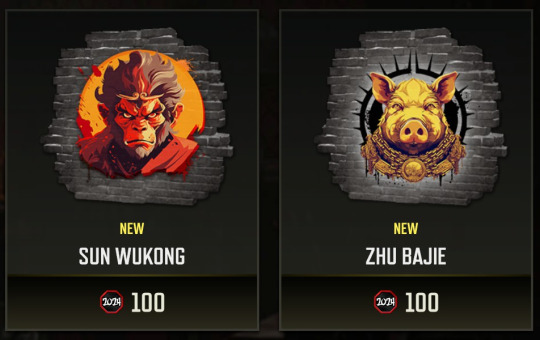
So briefly, I would like to discuss depictions of Zhu Bajie in popular media... who I generally refer to as Pigsy since, like many westerners - my first exposure to the character was the Japanese TV series Monkey (1978 - 1980) - in my case dubbed into English.

That's him on the right, with the muck rake. I also use this name because it's pretty much an accurate translation of the character's core premise after he is cast down into the mortal realm. It's how he's very consistently depicted:
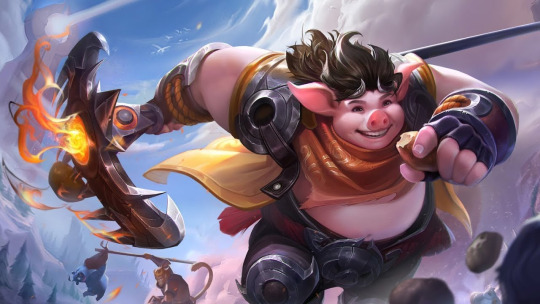
Honor of Kings (2015)

Monkie Kid (2020 - )
It's pretty much consistent to the point where the issue with googling for examples is finding the specific product they're linked to since he always looks like a pig man.... just like the PUBG unlockables above depict him as.
So you can imagine my surprise to discover that at some point in the development of this promotion, someone from the PUBG Corporation doubtlessly asked "Have we got the design for Pigsy ready yet?" and the reply was apparently "Yeah, made her real fucking sexy for you too! Just like you asked!"

This is also a rare PUBG outfit that look kind of different on a male model, than on the female model... turning into a full crop top rather than just a sexy bra.


It's also one where the chest design etc would probably get covered pretty quick the moment a player gets a vest... but I haven't had either the opportunity... or the burning desire to test that.
-wincenworks
#playerunknown's battlegrounds#pubg#zhu bajie#pigsy#paramilitary#video games#image#honor of kings#monkie kid#monkey#journey to the west#bikini armor battle damage#bikiniarmorbattledamage#babd#double standards#costume design
171 notes
·
View notes
Text

Horus Pegasus
The Pegasus pattern group first appeared following the start of hostilities between Union and the Aunic Ascendancy in Boundary Garden, a distant sector of distal space away from the Galactic Core. The timing of this outbreak may be related to the pattern group’s defining weapon, though skip-drone couriers from Union forces reported no encounters with the PG in Boundary Garden; instead, the Pegasus appeared in the Dawnline Shore, a stretch of colonial Armory space opposite Boundary Garden. The Pegasus appears to address HORUS’s need for a pattern group with extensive kinetic combat capabilities: by marrying the best targeting systems, subroutines, and weapons hardware in the HORUS codebase, collectivists have designed a PG that boasts a tremendously low identify/time-to-kill (ID/TTK) ratio in all theaters where kinetic weaponry is viable. As with many HORUS pattern groups, the Pegasus fields a signature weapon system: the Ushabti, a hostile impulse anti-corporeal weapon that operates with complete ignorance of even the most basic underpinnings of physics and thermodynamics. As such, it qualifies unambiguously as a paracausal weapon. The Ushabti’s precise function remains unknown to Union and Harrison Armory scientists, though radiological and gravitational signatures captured in the aftermath of the weapon’s use point toward a relationship with the Aunic Firmament. Studies are ongoing on Ras Shamra, the Armory’s chief research world, and in satellite campuses across the Dawnline Shore.
92 notes
·
View notes